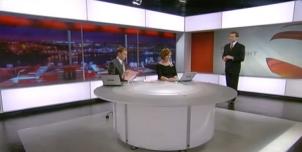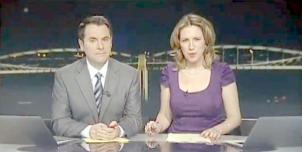Full Freeview on the Stockland Hill (Devon, England) transmitter
| Google Streetview | Google map | Bing map | Google Earth | 50.807,-3.106 or 50°48'25"N 3°6'20"W | EX14 9EP |
The symbol shows the location of the Stockland Hill (Devon, England) transmitter which serves 120,000 homes. The bright green areas shown where the signal from this transmitter is strong, dark green areas are poorer signals. Those parts shown in yellow may have interference on the same frequency from other masts.
_______
Digital television services are broadcast on a multiplexes (or Mux) where many stations occupy a single broadcast frequency, as shown below.
64QAM 8K 3/4 27.1Mb/s DVB-T MPEG2
H/V: aerial position (horizontal or vertical)
The Stockland Hill (Devon, England) mast is a public service broadcasting (PSB) transmitter, it does not provide these commercial (COM) channels: .
If you want to watch these channels, your aerial must point to one of the 80 Full service Freeview transmitters. For more information see the will there ever be more services on the Freeview Light transmitters? page.
Which Freeview channels does the Stockland Hill transmitter broadcast?
If you have any kind of Freeview fault, follow this Freeview reset procedure first.Digital television services are broadcast on a multiplexes (or Mux) where many stations occupy a single broadcast frequency, as shown below.
64QAM 8K 3/4 27.1Mb/s DVB-T MPEG2
H/V: aerial position (horizontal or vertical)
The Stockland Hill (Devon, England) mast is a public service broadcasting (PSB) transmitter, it does not provide these commercial (COM) channels: .
If you want to watch these channels, your aerial must point to one of the 80 Full service Freeview transmitters. For more information see the will there ever be more services on the Freeview Light transmitters? page.
Which BBC and ITV regional news can I watch from the Stockland Hill transmitter?

BBC Spotlight 0.8m homes 2.9%
from Plymouth PL3 5BD, 86km west-southwest (239°)
to BBC South West region - 107 masts.

ITV West Country News (West) 0.8m homes 2.9%
from Plymouth PL7 5BQ, 80km southwest (236°)
to ITV West Country region - 107 masts.
All of lunch, weekend and 50% evening news is shared with West Country (East)
Are there any self-help relays?
| Bickleigh | Transposer | 15 km N Exeter | 25 homes |
| Freshwater C/p | Active deflector | 2 km SE Bridport, Dorset | 250 homes (caravans) |
| Ladram Bay | Transposer | 15 km SE Exeter | 400 homes (caravans) |
How will the Stockland Hill (Devon, England) transmission frequencies change over time?
| 1961-80s | 1984-97 | 1997-98 | 1998-2009 | 2009-13 | 27 Mar 2019 | ||||
| VHF | A K T | A K T | A K T | A K T | A K T | ||||
| C9 | ITVwaves | ||||||||
| C22 | -ArqA | ArqA | |||||||
| C23 | ITVwaves | ITVwaves | ITVwaves | +D3+4 | D3+4 | ||||
| C25 | -SDN | SDN | |||||||
| C26 | BBC2waves | BBC2waves | BBC2waves | +BBCA | BBCA | ||||
| C28 | -ArqB | ArqB | |||||||
| C29 | C4waves | C4waves | C4waves | +BBCB | BBCB | ||||
| C33 | BBC1waves | BBC1waves | BBC1waves |
tv_off Being removed from Freeview (for 5G use) after November 2020 / June 2022 - more
Table shows multiplexes names see this article;
green background for transmission frequencies
Notes: + and - denote 166kHz offset; aerial group are shown as A B C/D E K W T
waves denotes analogue; digital switchover was 6 May 09 and 20 May 09.
How do the old analogue and currrent digital signal levels compare?
| Analogue 1-4 | 250kW | |
| BBCA, D3+4, BBCB | (-7dB) 50kW | |
| SDN, ARQA, ARQB | (-10dB) 25kW | |
| Mux 1*, Mux 2*, Mux A*, Mux B* | (-17dB) 5kW | |
| Mux C*, Mux D* | (-20dB) 2.5kW |
Which companies have run the Channel 3 services in the Stockland Hill transmitter area
|
|
Friday, 4 February 2011
Iain Marshall: If you could stop copying and pasting and ask an actual question, perhaps I could help?
| link to this comment |
I
Iain Marshall3:00 PM
Exeter
Hi,
I apologise for copy and pasting so much in my post of Thursday 3 February 2011 1:41PM. This was an accidental mistake, but the first part of my last post, (before the PS) is NOT COPY AND PASTED. I only copied and pasted the bit after.
The reason being is that I've asked you several questions, (long-winded but with as much info as possible, because I believe that the more info someone can provide the better the chance of getting the help that you require), BUT, unfortunately for me, you STILL haven't actually answered anything that I've asked.
In your first reply, you asked ME a question, to which I gave you an answer. Then in your second reply just a one line statement.
So, I will try ONCE more and keep each question as short and concise as I can.
1. Please can you confirm the bearing that I should be pointing my aerial. Should it be 69, 72 or 75 degrees or something else?
2. The inclination at my address is approx 66 degrees.
Does that mean that I should have my aerial at an angle of 66 degrees from upright or put another way, 24 degrees up from level?
3. You say that the commercial Mux's are on lower power until 2012. However www.digitaluk.co.uk shows that ALL muxs are on the highest power output that they will be NOW, with what seems like, if I'm interpreting their info correctly, the possibility of reduced power reaching my location from the 3 commercial Mux's lowering several times during 2012/13. Your statement and digitaluk's info appear at odds with each other.
Can you please confirm the situation?
4. Why are the 3 commercial Mux's broadcast on a much lower power output compared to Mux 1/BBC A and Mux 2/D3&4?
5. Is there a reason why can't they ALL be the same?
6. Do you have or can you find out if there is an explanation as to why ALL 5 Mux's have been OK for approx. 18 months (from Digital Switch-over in May 2009 until end of November or early December 2010), but now the 3 commercial Mux's, especially Mux C/Arqiva A (CH22),is so erratic with it's signal power level?
Many Thanks.
| link to this comment |
Iain's: mapI's Freeview map terrainI's terrain plot wavesI's frequency data I's Freeview Detailed Coverage
Iain Marshall: Here goes
1. e-ne 72° to Stockland Hill - Find out how to receive Freeview and Freeview HD | ukfree.tv - independent free digital TV advice .
2. The aerial must be mounted at no parallel to the ground;
3. "NOTE: SDN, Arqiva A and Arqiva B are expected to operate at 10kW until 2012. "
4. Because the would cause interference in the other non-switched regions to existing analogue service.
5. PSB multiplexes have the priority in the signal plans, they have to have the highest coverage;
6. Probably because you have a fault. See Freeview reception has changed? | ukfree.tv - independent free digital TV advice .
| link to this comment |
Saturday, 5 February 2011
I
Iain Marshall11:16 PM
Hi Brian,
Thanks for your answers.
Just a little clarification, if you can please?
1. Phil Wallace from Sherborne, earlier in this thread, (see his posts and your replies dated from Friday 7 January 2011 2:01PM through to Saturday 8 January 2011 12:31PM) asked if the 248° to Stockland Hill from his location is based on TRUE NORTH i.e. a map bearing or should he adjust for Magnetic Declination. You told him to subtract 3° thus using the bearing of 245°.
Based on that theory, I would like to clarify as to which is the correct bearing for me to use.
Should I also subtract 3° from the bearing that you just gave me thus using a bearing of 69° instead of 72°?
2. "The aerial must be mounted at no parallel to the ground".
Do you mean that the aerial MUST NOT be mounted parallel to the ground?
If that's the case, as I don't have a signal strength meter, I'm guessing that the best angle would have to be found by a bit of trial and error testing?
6. I don't quite see how a fault at my end would possibly affect reception to such an extent on Mux C/Arqiva A (CH22) that I loose picture completely on some occasions but be perfectly OK to watch on others whilst also NOT affecting the signal level from the 2 PSB Mux's at all and barely on the the other two commercial Mux's?
Many Thanks.
| link to this comment |
Sunday, 6 February 2011
Iain Marshall: 1. Yes, if you like. It is actually easier to do it using a signal meter.
2. No, I meant "parallel to the ground".
6. No, you don't.
| link to this comment |
I
Iain Marshall3:27 PM
Hi Brian,
thanks for the clarification on 1 & 2.
My point 6 just seems to be strange one, so, who really knows why it happens with no consistency in time of day or day of the week. I'm guessing, no-one can be 100% sure.
Anyway, I'll now test to see if there is any difference by moving aerial to 69° instead of 72° and monitor using my DVR's own signal strength meter and also double check the connections and cabling for any major bends/kinks/dodgy connectors.
If there is no or little improvement I guess, eventually, I WILL have to move the aerial outside.
Thanks, Brian, for your help and advice. We got there in the end.
| link to this comment |
Iain Marshall: Apologies if I wasn't too clear, I've had a terrible cold this week.
| link to this comment |
Monday, 7 February 2011
N
Noman Ansell8:43 AM
I've come across a similar problem to this, where one MUX became unwatchable and all the others were OK. It turned out to be local PC/Wireless Lan interference. Try mounting the aerial in different parts of the attic while maintaining the 72 deg. bearing, elements horizontal and aerial parallel to the ground. Also, if you can, try beaming the aerial through a side wall rather than the roof tiles. If this works (as it does for me), it will give you more reliable reception.
| link to this comment |
Noman Ansell: Thanks for that. Yes, indeed, this is a common problem for loft mounted aerial. The effect of roofing materials is unpredictable.
| link to this comment |
I
Iain Marshall4:18 PM
Hi Brian,
sounds like I was unfortunate to catch you when you were NOT at your best. I hope your cold goes soon so you'll be firing on all cylinders again.
| link to this comment |
Select more comments
Your comment please!




